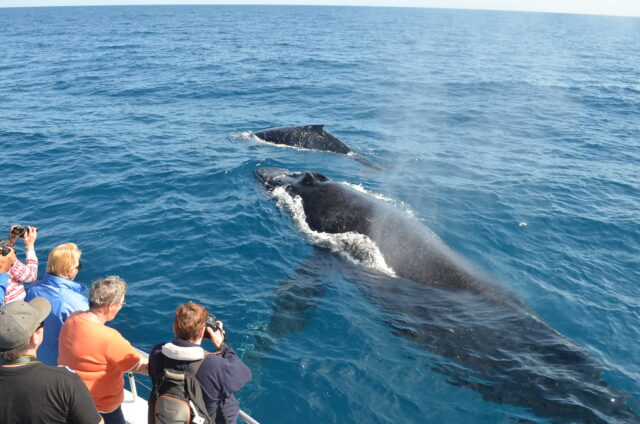To witness the mesmerizing world of whale watching in Alaska, plan your adventure during the peak season of May to September. Optimal weather conditions and a rich display of marine wildlife await. Whales are most active in nutrient-rich waters, showcasing captivating behaviors influenced by ocean currents and prey availability. Morning and late afternoon sightings offer varied experiences, with sunset cruises adding a unique touch. Migration patterns and breeding grounds guide these majestic creatures, creating a spectacle you won’t want to miss. Enhance your adventure by securing a knowledgeable guide and observing whale behaviors firsthand. Discover more about the wonders of Alaska’s whale watching.
Key Takeaways
– Summer months are best for whale watching in Alaska due to whale activity in nutrient-rich waters.
– Peak whale watching season in Alaska is from May to September with optimal weather conditions.
– Whales are more active in the early mornings or late afternoons, offering better sightings.
– Migration patterns affect whale distribution, creating prime whale watching opportunities.
– Weather considerations like wind, rain, fog, and sunlight impact the quality of whale watching experiences.
Best Time of Year for Whale Watching
To maximize your chances of spotting whales in Alaska, plan your visit during the summer months when these majestic creatures are most active in the nutrient-rich waters. During the best time to see whales in Alaska, you’ll witness fascinating behavior as they feed, breach, and socialize in the vast ocean. One key factor influencing their presence is the intricate network of ocean currents that carry nutrients and prey, attracting whales to specific areas along the Alaskan coast.
Whale behavior in Alaska is heavily influenced by the seasonal changes in ocean currents. As summer arrives, warm currents bring a surge of nutrients, triggering a chain reaction in the marine ecosystem. Whales follow these currents to areas abundant with fish and plankton, essential for their survival. This migration pattern creates prime opportunities for whale watching enthusiasts during the best time to see whales in Alaska to observe these magnificent creatures up close.
Understanding the connection between whale behavior and ocean currents is crucial for planning your whale-watching expedition. By timing your visit during the summer months when these factors align, you enhance your chances of a truly mesmerizing encounter with Alaska’s marine giants.
Peak Whale Watching Season in Alaska
During the peak whale watching season in Alaska, you’ll witness the magnificent creatures in their natural habitat. The best viewing spots along the Alaska coastline offer optimal opportunities to observe these majestic animals.
Understanding the whale migration patterns can enhance your experience by increasing the likelihood of encountering different species at specific times.
When to Go
The peak season for whale watching in Alaska typically occurs from May to September. During this time, you can experience optimal weather conditions and increased tour availability, enhancing your chances of spotting these majestic creatures. Here are some key points to consider when planning your adventure:
– Mild Temperatures: Enjoy comfortable temperatures ranging from 50°F to 65°F, providing a pleasant outdoor experience.
– Extended Daylight Hours: Take advantage of the long daylight hours in the Alaskan summer, giving you more time for whale watching excursions.
– Calmer Seas: Experience relatively calmer ocean conditions during these months, ensuring a smoother sailing experience.
– Abundance of Wildlife: Witness not only whales but also a variety of other marine wildlife thriving in the rich Alaskan waters.
Best Viewing Spots
Exploring prime whale viewing locations in Alaska during the peak season unveils a diverse array of habitats teeming with marine life. Utilizing binocular basics enhances your chances of spotting these majestic creatures from prime photography spots along the coastline.
Consider taking boat excursions for a closer encounter with whales in their natural habitat. Shoreline sightings are also common, allowing you to witness these giants breaching and feeding near the shore. Keep a keen eye out for spouts and tails breaking the water’s surface.
Some recommended spots include Juneau, Seward, and the Inside Passage. These areas offer excellent vantage points for capturing unforgettable moments of whale watching. Get ready to be awestruck by the beauty of these marine marvels in Alaska.
Whale Migration Patterns
Navigating the intricate whale migration patterns in Alaska requires a keen understanding of the seasonal movements of these majestic marine mammals. When exploring the peak whale watching season, consider the following:
– Whale Behaviors: Witness the whales’ feeding frenzy as they hunt for schools of fish to sustain themselves during their migration.
– Whale Communication: Listen closely to the melodious sounds of whale songs echoing through the waters, a form of communication that plays a crucial role in their social interactions.
– Migration Routes: Follow the well-established migration routes that whales have been using for generations, guiding them to their breeding and feeding grounds.
– Group Dynamics: Observe the intricate group dynamics within pods as they travel together, showcasing the strong bonds and cooperative behaviors among these magnificent creatures.
Ideal Time of Day for Spotting Whales
During the early mornings or late afternoons, whales are typically more active and easier to spot in the Alaskan waters. Morning sightings offer a serene atmosphere as the sun rises, illuminating the misty waters where whales often breach the surface. The cool, crisp air carries the sound of their exhales, creating a symphony of nature.
Afternoon sightings, on the other hand, provide a different experience with whales feeding actively before the sun sets. This time of day offers better visibility due to the angle of the sunlight, making it easier to catch a glimpse of these majestic creatures.
For those seeking a unique adventure, sunset cruises and night tours are excellent options. Sunset cruises allow you to witness the play of colors in the sky as the day transitions into night, all while watching whales gracefully swim in the fading light. Night tours, although less common, can be incredibly rewarding for the adventurous souls, as the darkness adds a sense of mystery to the whale-watching experience.
Whether you choose the tranquility of the mornings or the vibrancy of the afternoons, timing your whale-watching adventure in Alaska can greatly enhance your chances of spotting these incredible marine mammals.
Factors Affecting Whale Sighting Opportunities
Whale sighting opportunities in Alaska are influenced by various environmental factors that play a significant role in the presence and behavior of these marine mammals. When considering whale behavior and the impact of ocean currents, several key elements come into play:
– Prey Availability: The distribution of whale prey, such as krill and small fish, can attract whales to specific areas where food is abundant.
– Temperature Gradients: Whales often follow temperature gradients in the water, as these can indicate areas of upwelling where nutrients are concentrated.
– Underwater Topography: Submarine canyons and underwater mountains can create upwelling zones that support diverse marine life, attracting whales to these productive areas.
– Migration Patterns: Understanding the seasonal movements of different whale species is crucial, as some may pass through Alaska during specific times of the year due to migration routes influenced by ocean currents.
These factors interact in complex ways, influencing where and when whales are likely to be spotted in Alaskan waters. By considering these environmental dynamics, you can enhance your chances of experiencing unforgettable whale sightings during your Alaska adventure.
Whale Migration Patterns in Alaska
Whale migration patterns in Alaska are shaped by distinct migration routes and specific breeding grounds. Understanding these migration routes can provide insight into the seasonal movements of different whale species in Alaskan waters.
Migration Routes
Navigating the vast waters of the North Pacific Ocean, these magnificent marine mammals in Alaska follow meticulously charted migration routes every year. As they journey through the cold Alaskan waters, you can witness the grand spectacle of their migration. Imagine:
– Massive humpback whales gracefully gliding in pods, their haunting songs echoing through the ocean.
– The powerful orcas swiftly cutting through the waves, their distinct black and white markings glistening in the sunlight.
– The gentle gray whales migrating in a steady rhythm, their ancient migration patterns preserved through generations.
– The elusive blue whales, the largest animals on Earth, majestically making their way along the Alaskan coastline.
Each of these awe-inspiring creatures plays a vital role in the intricate web of life in the North Pacific.
Breeding Grounds
As these majestic marine mammals continue their journey through the cold Alaskan waters, the focus now shifts to the intricate paths leading to their breeding grounds. Migrating whales exhibit fascinating mating behavior along these routes, where males compete for females through elaborate displays of strength and vocalizations.
The calving season, a crucial period in the whales’ reproductive cycle, takes place in these breeding grounds. Here, mother whales nurture their newborn calves, teaching them essential survival skills in preparation for their long journey back to the feeding grounds.
Witnessing these natural wonders unfold in the pristine waters of Alaska offers a glimpse into the intimate lives of these magnificent creatures, making it a truly awe-inspiring experience for those seeking a deeper connection with the marine world.
Weather Considerations for Whale Watching
Considering the prevailing weather conditions is crucial for optimal whale watching experiences in Alaska. When planning your adventure, keep in mind the diverse weather patterns that can influence your outing.
Here are some weather considerations to bear in mind:
– Windy Conditions: Strong winds can create choppy waters, making it challenging to spot whales and causing potential discomfort on the boat.
– Rainy Days: Rainy weather can obstruct visibility, making it harder to see the majestic creatures as they surface for air.
– Foggy Weather: Fog can shroud the waters, reducing visibility and making it difficult to track the movements of whales in the vicinity.
– Sunny Skies: While sunny weather may offer clear views and pleasant conditions, be cautious of glare off the water, which could hinder whale spotting.
Tips for Enhancing Your Whale Watching Experience
To enhance your whale-watching experience in Alaska, prioritize securing a knowledgeable guide who can provide insightful information about the behavior and habits of these magnificent marine mammals. Understanding whale behavior is key to maximizing your experience. Look for signs like breaching, tail slapping, or spy hopping, which can indicate different behaviors such as feeding, socializing, or communication within the pod.
When it comes to capturing these moments through photography, consider bringing a camera with a zoom lens to get up close without disturbing the whales. Be patient and ready to snap photos at any moment, as whales can surface unpredictably. Remember to respect their space and never approach too closely.
Additionally, pay attention to the direction of the light for optimal photo quality. Backlit photos can create stunning silhouettes of whales against the water. Experiment with different angles and settings to capture the essence of these majestic creatures in their natural habitat. By combining knowledge of whale behavior with photography tips, you can truly enhance your Alaska whale-watching adventure.
Conclusion
As you plan your whale-watching adventure in Alaska, consider the best time of year, peak season, ideal time of day, and factors affecting sightings.
Understanding whale migration patterns and weather conditions will enhance your chances of spotting these majestic creatures.
By following these tips and being prepared, you can maximize your whale-watching experience and witness the wonder of these magnificent animals in their natural habitat.
Prepare to be amazed by the beauty of Alaska’s marine life.
Apart from this, if you are interested to read an amazing article on MF Doom and Sherry Dyson, then visit our Lifestyle category.







